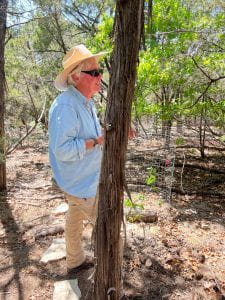
The Vireo Preserve is a habitat restoration area adjacent to the Wild Basin Preserve, both of which are a part of the Balcones Canyonlands Preserve (BCP), named after its very own Black-capped Vireos.. Originally, the land was purchased by the Davenport family for $40,000 in the 1940s. During the time of ownership, there were many brush composites throughout the area. These composites sat without moving for many years. Throughout these years, the composites began to accumulate a large amount of fuel. One day, someone driving by tossed a cigarette out the window which sparked a fire that reigned for days. By the time the fire went out, hundreds of acres of the land had been burned, destroying a significant amount of the habitat and diversity that existed before. This is significant to the 15:1 ratio of conservation acreage allocated to the Golden Cheeked Warblers and Black-capped Vireos, respectively, because of the Golden Cheeked Warbler being listed as endangered due to habitat loss.
Following the discovery that the Black-capped Vireos were endangered, the city of Austin was looking to preserve as much land in Western Travis County as they could. 125,000 acres was set aside to help the Golden Cheeked Warbler and the Black-capped Vireos but they were told that of that 125,000, the city could only get 32,000. 2,000 of these acres were specifically used for the protection and conservation of the Black-capped Vireos, while the other 30,000 was for the Golden Cheeked Warblers. In 1992, the city of Austin passed a $22 million bond to purchase land for a preserve. 200 acres at that time was $10 million and it took 4 years to convince people that this land was necessary despite it being attached to a pre-existing preserve. The city of Austin then passed a variant that reallocated the development of the land a few miles away which brought the 10 million dollar price tag to 2 million dollars. Since then, Vireo’s main goal has been to get the preserve into a functional system that sustains all organisms in building up soil and diversity to increase wildlife as it progresses and evolves.
 During the hike on the preserve, Jim detailed several interesting facts about the area and its history. One of the things we learned on the trip during our hike on the preserve was about is Oak Wilt, a fungal disease that spreads quickly from tree to tree and destroys their root systems. Jim also showed us some of the restoration efforts being done on the preserve, such as the brush berms, which are used to dam up water so it is captured into the soil rather than being wasted as runoff in unneeded areas. Jim discussed the past fires on the preserve during different periods displayed on maps he had on hand, and also told us about the damage done to some of the plants due to the small winter storm that had passed through Austin earlier on in the year. During the trip we were also able to learn about and even hear some of the Golden Cheek Warblers in the area, which were named Mellow Yellow, Sunshine, and Hill Guy!
During the hike on the preserve, Jim detailed several interesting facts about the area and its history. One of the things we learned on the trip during our hike on the preserve was about is Oak Wilt, a fungal disease that spreads quickly from tree to tree and destroys their root systems. Jim also showed us some of the restoration efforts being done on the preserve, such as the brush berms, which are used to dam up water so it is captured into the soil rather than being wasted as runoff in unneeded areas. Jim discussed the past fires on the preserve during different periods displayed on maps he had on hand, and also told us about the damage done to some of the plants due to the small winter storm that had passed through Austin earlier on in the year. During the trip we were also able to learn about and even hear some of the Golden Cheek Warblers in the area, which were named Mellow Yellow, Sunshine, and Hill Guy!
Post by Makai Rivas & Jana Carter
Photographs by Katie & Jana
Leave a Reply